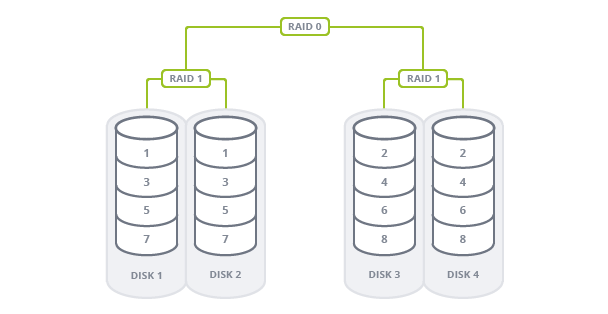How To Set Up Raid 10
RAID is an acronym for Redundant Array of Independent (or Inexpensive) Disks. It is a method of storing information on hard disks for greater protection and/or performance. At that place are several different storage methods, named levels, numbered from 0 to 9.
Some levels can be combined to produce a 2-digit RAID level. RAID 10, and so, is a combination of levels 1 (mirroring) and 0 (striping), which is why it is also sometimes identified as RAID 1 + 0. Mirroring is writing data to two or more hard bulldoze disks (HDDs) at the aforementioned time – if ane disk fails, the mirror epitome preserves the information from the failed disk. Striping breaks data into "chunks" that are written in succession to unlike disks. This improves performance considering your calculator tin can access data from more than than one disk simultaneously. Striping does not, however, provide redundancy to protect information, which is why it is designated 0.
The Advantages Of RAID 10
Combining these two storage levels makes RAID ten fast and resilient at the same time. If you demand hardware-level protection for your data and faster storage performance, RAID 10 is a simple, relatively inexpensive prepare. RAID 10 is secure considering mirroring duplicates all your data. Information technology'south fast because the data is striped across multiple disks; chunks of information can exist read and written to unlike disks simultaneously.

To implement RAID ten, you need at least four concrete hard drives. You also need a disk controller that supports RAID.
RAID Is Non Fill-in
Here's one important caveat near RAID and backup. Although RAID writes data to 2 disks simultaneously, it is not a backup. If your operating arrangement or software, rather than the hd, corrupts your data, this corrupted information is sent to both disks and simultaneously corrupts both drives. Withal, a backup is a re-create of data, which is stored somewhere else and is discrete from the original information both in space and time. Backup data is non corrupted unless you specifically back up corrupted information. In short, even if y'all use RAID, you still must use an effective fill-in software.
RAID ten protects you from a single bulldoze failure — the mirror takes over for a time while you replace the failed disk and rebuild the copy.
However, keep in mind that RAID 10 redundancy cuts your usable deejay infinite in one-half. Since everything is mirrored (duplicated), 4 2TB disks in RAID 10 give you lot a total chapters of 4TB of usable space.
RAID five Vs. RAID ten: What's The Departure?
And then, you may ask: why wouldn't I use RAID 5 instead? It gives me 6TB of full capacity, a performance advantage, and redundancy that protects me from a single drive failure.
The biggest deviation between RAID 5 and RAID 10 is how information technology rebuilds the disks. RAID ten only reads the surviving mirror and stores the copy to the new drive you replaced. Your usual read and write operations are almost unchanged from normal operations.
Withal, if a drive fails with RAID 5, it needs to read everything on all the remaining drives to rebuild the new, replaced disk. Compared to RAID 10 operations, which reads merely the surviving mirror, this extreme load means you lot have a much higher gamble of a second deejay failure and data loss.
Call up to ever utilise identical disks when creating a RAID 10 array. The deejay geometry (number of heads, cylinders, etc.) is critical and it is strongly recommended NOT to employ dissimilar disks.
Protecting Your Data Is Easier Than Always
Since the costs of disks are decreasing, adding incremental storage infinite is now less expensive than ever earlier, whether you are adding additional disks to back up your RAID 10 array or replacing the deejay controller on your motherboard if it doesn't back up RAID x.
You need to configure RAID 10, only it isn't difficult and just takes a few minutes. The organisation or disk controller software includes install routines that walk you through the process.
Source: https://www.acronis.com/id-id/blog/posts/whats-raid10-and-why-should-i-use-it/

0 Response to "How To Set Up Raid 10"
Post a Comment